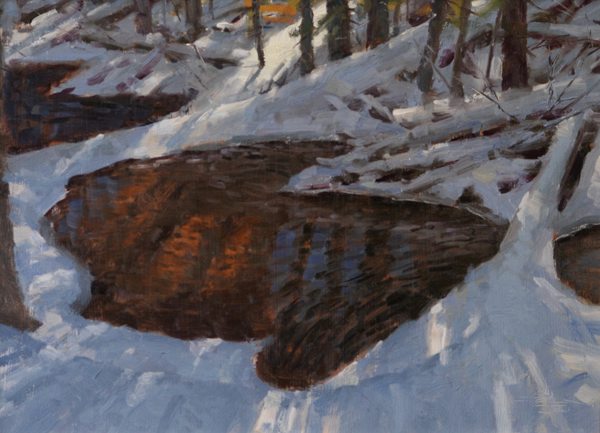 With the holidays over, I can finally get my
With the holidays over, I can finally get my 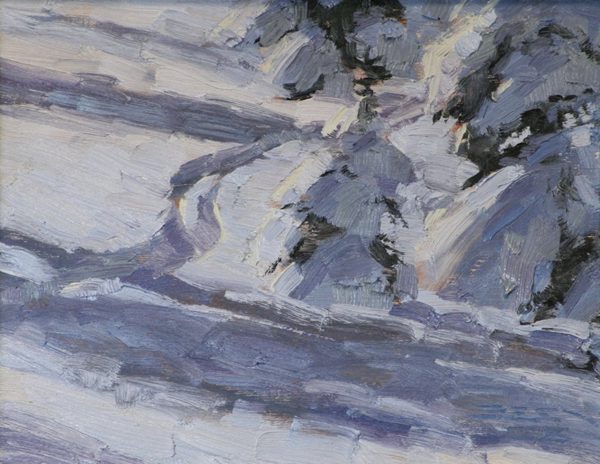 head in to some serious painting again. It’s time to paint snow and it’s one of my favorite subjects.
head in to some serious painting again. It’s time to paint snow and it’s one of my favorite subjects.
Hardly any painting experience can top going out on a brisk winter morning and finding light falling through trees and a small creek peaking through a new dumping of pow. I love the way snow unifies the structure of what it’s covering. The way it bulges and undulates subtley describing what’s beneath, is something to behold. One can always take a picture and go back to the studio to paint in comfort and warmth, but the lense is never quite capable of capturing the vibrant cools and warms and the transitions of value and edge. To live the experience, and to actually see this and study it for a couple of hours is the only way to paint the TRUTH.
I ended up likeing this composition so much that I painted a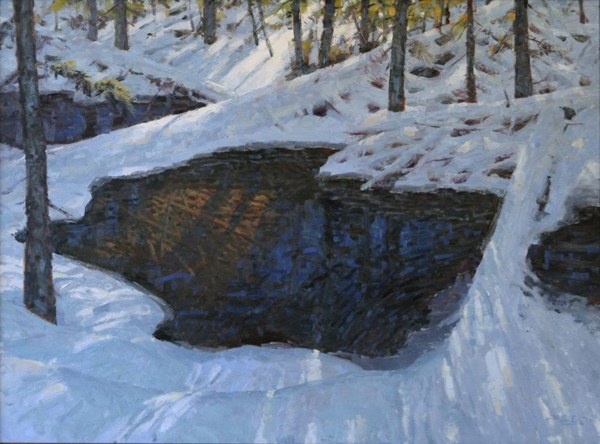 larger version of it. I went 30X40 with the new painting which forced me to really describe the form of the snow and work out, with greater precision, the reflections and movement of the water pools..
larger version of it. I went 30X40 with the new painting which forced me to really describe the form of the snow and work out, with greater precision, the reflections and movement of the water pools..
The painting to the left is the 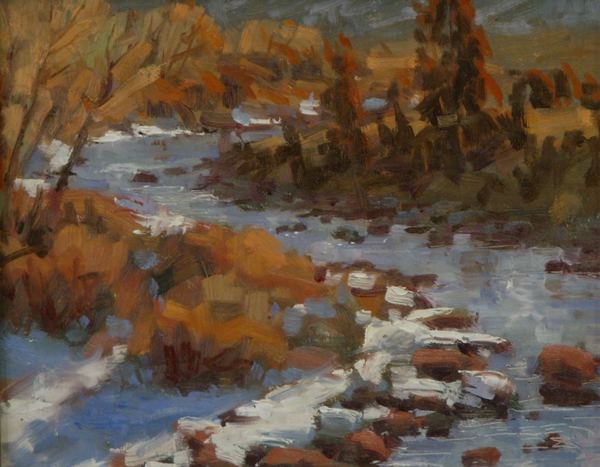 Arkansas River in the last light of the evening. I say evening, but it was actually about 4:30 in the afternoon and the sun sets behind the Collegiate peaks at about 4:45 in early January.
Arkansas River in the last light of the evening. I say evening, but it was actually about 4:30 in the afternoon and the sun sets behind the Collegiate peaks at about 4:45 in early January.
When one learns to look for it, there are so many colors in the shadows of snow.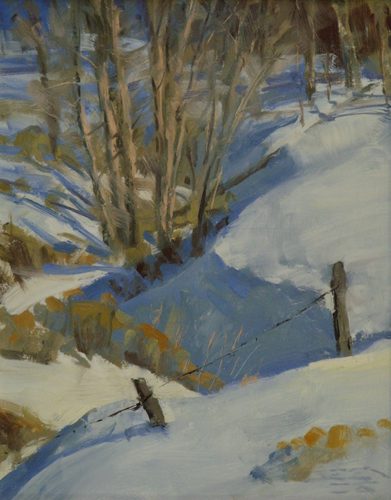 It’s such a reflective surface that light bounces all over the place with a difference in color and value at every plane change. The shadows need to be dark enough to read as shadows, but not as dark or saturated as sky reflections in the water. One should be mindful, also, of the subtle core shadows that help delineate form in the shadow masses.
It’s such a reflective surface that light bounces all over the place with a difference in color and value at every plane change. The shadows need to be dark enough to read as shadows, but not as dark or saturated as sky reflections in the water. One should be mindful, also, of the subtle core shadows that help delineate form in the shadow masses.
In the lit masses of snow, temperature changes will help describe the form in such an amazing way. The lightest light and the warmest color of the snow is where the sun 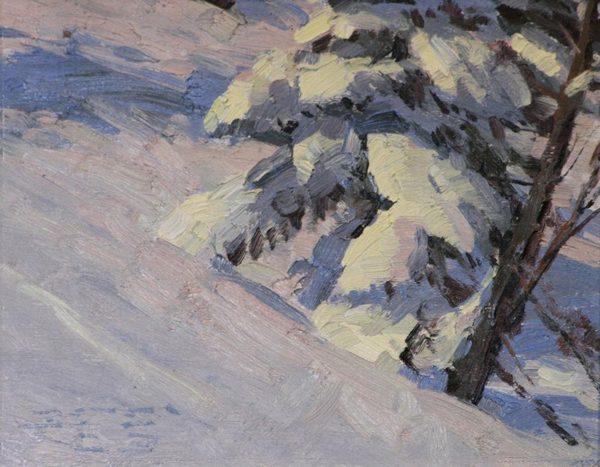 bounces off of its surface and in to one’s eyes. I have found that by taking the other lit surfaces down a notch in value, it enables me to pop the surfaces that hit my retinas hardest.
bounces off of its surface and in to one’s eyes. I have found that by taking the other lit surfaces down a notch in value, it enables me to pop the surfaces that hit my retinas hardest.
Then there’s the water. When painting water it’s important to consider a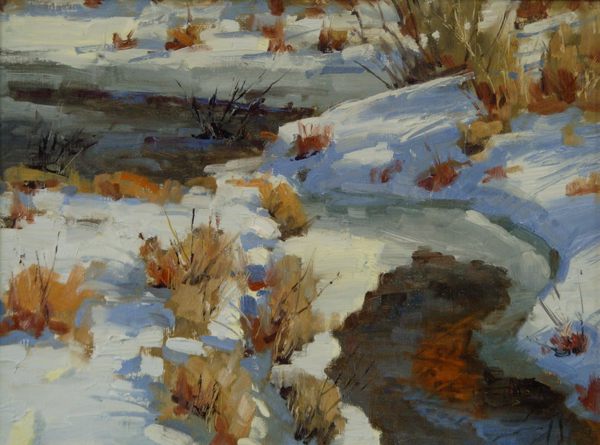 few key elements. The surface of the water as well as what I call the subsurface structure or bottom, if it can be seen, are very important. By squinting one can assess the value relationship with the snow’s shadows and lit areas and helps one assess the general or average color of the mass. Another thing to look for is the clarity of the water. If the water is gin clear as it usually is in the Rockys, the surface is more reflective and shadows shoot right through the surface and illuminate the subsurface structure in the harmony of
few key elements. The surface of the water as well as what I call the subsurface structure or bottom, if it can be seen, are very important. By squinting one can assess the value relationship with the snow’s shadows and lit areas and helps one assess the general or average color of the mass. Another thing to look for is the clarity of the water. If the water is gin clear as it usually is in the Rockys, the surface is more reflective and shadows shoot right through the surface and illuminate the subsurface structure in the harmony of 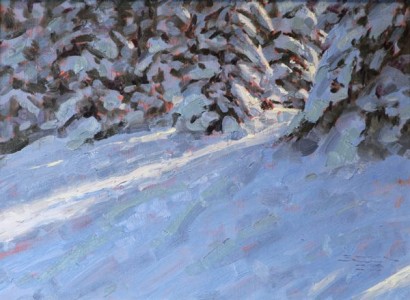 the water’s average color. If the water is muddy as in high runoff times or flooding, then the surface is less reflective and shadows cast by surrounding objects stay on the surface.
the water’s average color. If the water is muddy as in high runoff times or flooding, then the surface is less reflective and shadows cast by surrounding objects stay on the surface.
You’ll always see a lot of truth in my work because of the amount of on-location painting that I do. I think it’s the single most influencial part of my growth and understanding as a painter.
Please feel free to comment on the post or on painting snow and water, and thanks for taking the time.


4 Comments
First time I’ve seen your website and this “blog” style is definitely playing to your strength. (Did you do this website yourself. Or who did it for you? Cost?)
I am concentrating on learning to paint snow this year. I even took notes from your comment on the blog. Excellent. You explain well. I’ll be you are a fantastic teacher. Keep me in mind for future workshops.
I really enjoyed reading your notes on plein air painting in winter. I think that they will be something I reference often as I grow as an artist. Thank you for your newsletter and the suggestions you extend to your subscribers. I’ve been to your Salida studio and think your paintings are beautiful. I look forward to taking some of your workshops in the near future.
Gut!
Fantastic job writing Painting Snow in the Field.